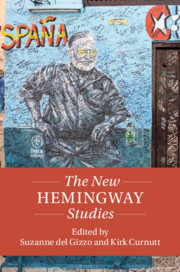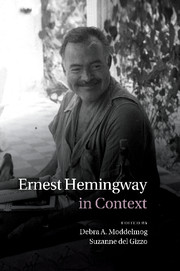33 results
Contents
-
- Book:
- The New Hemingway Studies
- Published online:
- 30 August 2020
- Print publication:
- 17 September 2020, pp v-vi
-
- Chapter
- Export citation
Part I - The Textual Hemingway
-
- Book:
- The New Hemingway Studies
- Published online:
- 30 August 2020
- Print publication:
- 17 September 2020, pp 15-96
-
- Chapter
- Export citation
Copyright page
-
- Book:
- The New Hemingway Studies
- Published online:
- 30 August 2020
- Print publication:
- 17 September 2020, pp iv-iv
-
- Chapter
- Export citation
Part II - Identities
-
- Book:
- The New Hemingway Studies
- Published online:
- 30 August 2020
- Print publication:
- 17 September 2020, pp 97-186
-
- Chapter
- Export citation
Index
-
- Book:
- The New Hemingway Studies
- Published online:
- 30 August 2020
- Print publication:
- 17 September 2020, pp 302-312
-
- Chapter
- Export citation
Conclusion
- from Part III - Global Engagements
-
- Book:
- The New Hemingway Studies
- Published online:
- 30 August 2020
- Print publication:
- 17 September 2020, pp 255-258
-
- Chapter
- Export citation
Introduction - Hemingway in the New Millennium
-
-
- Book:
- The New Hemingway Studies
- Published online:
- 30 August 2020
- Print publication:
- 17 September 2020, pp 1-14
-
- Chapter
- Export citation
Contributors
-
- Book:
- The New Hemingway Studies
- Published online:
- 30 August 2020
- Print publication:
- 17 September 2020, pp vii-x
-
- Chapter
- Export citation
Works Cited
-
- Book:
- The New Hemingway Studies
- Published online:
- 30 August 2020
- Print publication:
- 17 September 2020, pp 259-301
-
- Chapter
- Export citation
Chapter 6 - Family Dynamics and Redefinitions of “Papa”-hood
- from Part II - Identities
-
-
- Book:
- The New Hemingway Studies
- Published online:
- 30 August 2020
- Print publication:
- 17 September 2020, pp 99-114
-
- Chapter
- Export citation
Part III - Global Engagements
-
- Book:
- The New Hemingway Studies
- Published online:
- 30 August 2020
- Print publication:
- 17 September 2020, pp 187-258
-
- Chapter
- Export citation

The New Hemingway Studies
-
- Published online:
- 30 August 2020
- Print publication:
- 17 September 2020
21 - Ethnic Stereotyping
- from Part IV - Historical and Social Contexts in the Jazz Age (1918–1929)
-
-
- Book:
- F. Scott Fitzgerald in Context
- Published online:
- 05 February 2013
- Print publication:
- 18 March 2013, pp 224-233
-
- Chapter
- Export citation
Contributors
-
-
- Book:
- F. Scott Fitzgerald in Context
- Published online:
- 05 February 2013
- Print publication:
- 18 March 2013, pp xi-xx
-
- Chapter
- Export citation
Figures
-
- Book:
- Ernest Hemingway in Context
- Published online:
- 18 December 2013
- Print publication:
- 17 December 2012, pp ix-x
-
- Chapter
- Export citation
Notes on Contributors
-
-
- Book:
- Ernest Hemingway in Context
- Published online:
- 18 December 2013
- Print publication:
- 17 December 2012, pp xi-xxii
-
- Chapter
- Export citation
Resources
-
- Book:
- Ernest Hemingway in Context
- Published online:
- 18 December 2013
- Print publication:
- 17 December 2012, pp 419-434
-
- Chapter
- Export citation
Chapter 12 - Cult and Afterlife
- from Representations:
-
-
- Book:
- Ernest Hemingway in Context
- Published online:
- 18 December 2013
- Print publication:
- 17 December 2012, pp 119-129
-
- Chapter
- Export citation
Preface
-
- Book:
- Ernest Hemingway in Context
- Published online:
- 18 December 2013
- Print publication:
- 17 December 2012, pp xxiii-xxviii
-
- Chapter
- Export citation

Ernest Hemingway in Context
-
- Published online:
- 18 December 2013
- Print publication:
- 17 December 2012

